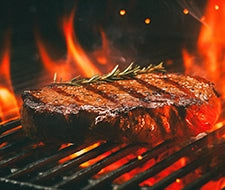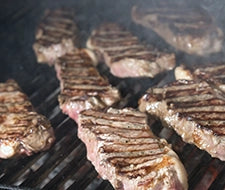Grilling neck steak is an art that is mastered with patience and practice. The quality of the meat, choosing the right utensils and following the best grilling techniques are essential. With the right storage and care, your neck steaks will not only taste incredibly delicious, but will also last a long time. So, take on the challenge - we'll help you with our tips.
Grilling neck steak - what you need to know now!
Grilling neck steak always requires preparation. This includes the right equipment, such as a measuring device for the core temperature and of course setting up an indirect and direct zone on the grill to cook the meat optimally. If you want to marinate your pork neck beforehand, an herb-based oil mixture is always recommended, and choose olive oil and spices that taste best to you.
Grilling neck steak - the right preparation
Along with pork belly and pork fillet, neck steaks are probably the most popular cuts of meat on German barbecues. They are tender as butter, like a pork fillet, and juicy, like chicken wings . But they are streaky with fat and have a spicy taste. But to fully enjoy pork neck steaks, they need to be of good quality. Only high standards can be grilled perfectly, and a high-quality piece of meat is essential for BBQs. It is best to buy pork from a butcher. That way you can be sure that you are always getting high quality and you can put the steak on the grill with a clear conscience.
Before you start the gas grill or charcoal grill, remember that the perfect neck steak begins with its preparation. An essential tip is to choose the right meat. A first-class pork neck steak impresses with its light marbling, which guarantees unbeatable juiciness, tenderness and a kick of flavor when prepared.
Always go for fresh meat from regional suppliers. A balanced ratio of meat to fat gives pork neck steaks a delicious aroma. Pork from Iberico pigs or other old breeds, such as Duroc or Bunten Bentheimer pigs, is particularly tender and juicy. It is also worth trying the Special Cut Presa , which is also a particularly juicy and aromatic component of pork neck .
Grilling neck steaks: The right marinade
Marinating neck steaks : Olive oil, fresh spices, mustard and herbs give the grilled meat an additional flavor dimension - why rely on ready-made products when making your own marinade offers the opportunity to design the flavor profile exactly to your own taste. If you don't want a marinade, you should use a rub. In principle, any meat can be refined with the spices you like best. As a guide, we can give you the following ingredients for a rub: pepper, salt, sugar, paprika and various herbs of your choice. Both a rub and a marinade are possible for grilled neck steaks. However, if you prefer the unadulterated taste of the meat , you should avoid this.
Once the meat has marinated, patience is required. It should be given enough time to absorb the marinade deep into its fibers - a few hours is a good start, but overnight in the fridge is best. And finally, before going on the grill, the food should come to room temperature to ensure it cooks evenly.
Even if your own spice mixture is a success, the marinated neck steaks must be freed of excess marinade to prevent a fat fire when they are placed on the hot grill. This way, the piece of pork can be grilled at medium heat until it is nice and juicy, but still crispy .
Grilling neck steak - it all depends on the technique
Preparing neck steaks is an art form that offers different taste experiences depending on the technique chosen. Each method has its own nuances and advantages and can make the difference between a good and an outstanding result. The equipment is important here. Always have a measuring device for the core temperature ready. The core temperature is crucial for the desired degree of doneness. This is the only way you can be 100% sure that you will get a perfectly grilled neck steak . The cooking time then logically depends on the temperature you want your steak to be. So it's not rocket science.
There are different methods for grilling a neck steak . Always set up a direct and indirect zone on the grill so that you can use both techniques and be more controlled when grilling. This ensures greater safety and a lower error rate when grilling.

direct grilling
Let's start with the direct grilling method. With this technique, the food to be grilled is placed directly above the heat source. This ensures an intensive supply of heat, which forms a crispy and aromatic crust on the food. This method is ideal, especially for steaks that are not too thick . It promises a juicy interior in a short grilling time. However, direct grilling also requires constant attention in order to achieve the perfect level of browning while avoiding overcooking.

Indirect grilling
In contrast, indirect grilling is a method that is a little gentler and more gentle. This involves placing the steak in an area of the grill that is not directly over the heat source. The meat cooks more slowly in this case, which means it is evenly cooked. This technique is particularly ideal for thicker steaks or those that are coated in a marinade that could tend to burn if the heat is too high. An additional benefit is the smoky flavor that is created by the slower cooking and lower heat. This gives the steak a deeper, more complex flavor.
Grilling neck steak: The optimal storage
Proper storage of meat, especially premium neck steaks , is crucial when it comes to preserving taste and quality over a longer period of time. A steak that is not stored optimally will quickly lose its aroma, texture and freshness. So here are a few tips:

Proper cooling
As soon as you receive your steak from the butcher , it should be put in the fridge immediately. This rapid cooling not only minimizes bacterial growth, but also keeps the steak in top condition. It is recommended that you leave the meat in its original packaging. This special packaging protects the meat from external influences and preserves its breathability.

Longer storage
If you plan to enjoy the steak in the next few days, the coldest part of your fridge - often the bottom - is the ideal storage location. For longer storage, such as several weeks, freezing is essential. To freeze the steak optimally, first wrap it in plastic wrap and then place it in a freezer bag. This prevents freezer burn and preserves the flavor of the meat.

thawing
Be careful when defrosting: A frozen steak cannot be rushed. Microwaves and defrosting at room temperature are taboo. The patient method is to slowly defrost the meat in the refrigerator over hours or days.
A neck steak is cut from the back or shoulder of a pig. The fat content of the meat can vary depending on the pig, so not all neck steaks are equally fatty. These delicious steaks taste particularly good when cooked on the grill, but they can also be easily pan-fried.
Of course, you should marinate beef steaks, because only with the marinade do steaks become nice and tender. Simply pat the steak dry to remove excess moisture, then you can decide how you want to put the marinade together. Whether you use garlic, soy sauce or lemon juice - the decision is up to you, some even use a little oregano.
When grilling neck steak, the rule of thumb is six to eight minutes - with a thickness of 2 to 3 centimeters. It is important that the meat is turned halfway through the cooking time.
Grilling neck steak is a challenge, but with the right meat (from the butcher) and the correct preparation, it is easy to master. Preparation always includes the right equipment, such as a measuring device for the core temperature and of course setting up an indirect and direct zone on the grill to cook the meat optimally. If you want to marinate your pork neck beforehand, an herb-based oil mixture is always recommended; choose olive oil and spices that you like best. Then leave it in the fridge for a few hours. A rub is also possible; here too, choose spices that you like best and mix them together. When storing the neck steak, it is recommended to store the meat in the coldest part of the fridge (at the very bottom) and if you want to keep it for a longer period of time, you have to freeze it. The only important thing is that you let it thaw again in the fridge, otherwise the flavor will be lost.

